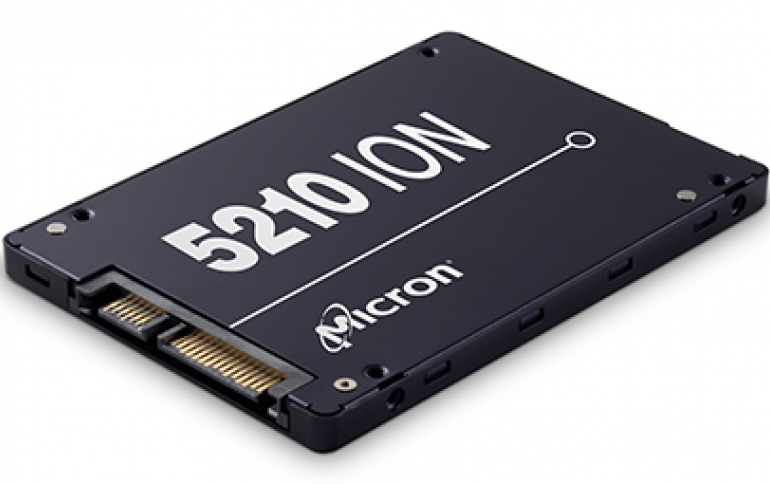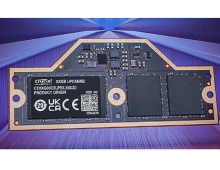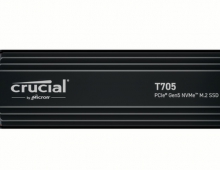
Micron Releases The 5210 ION SSD, Starts Mass Production of Monolithic 12Gb LPDDR4x DRAM
Micron Technology has made available the QLC-based Micron 5210 ION enterprise SATA SSD, and has begun mass production of the 12Gb low-power double data rate 4x (LPDDR4x) DRAM for mobile devices.
Announced last May, the Micron 5210 ION enterprise SATA SSD is the world's first solid-state drive based on quad-level cell (QLC) NAND technology. Available globally today, the Micron 5210 ION enterprise SATA SSD has been designed for data centers, and follows the recent launch of the Crucial P1 NVMe QLC SSD for consumer markets.
High-density Micron QLC 64-layer 3D NAND flash media achieves densities of one terabit on a single chip, enabled by a new cell architecture. Micron positions the new SSD as a replacement to hard disk drives, touting advantages such as the the ease of SATA, economics and the speed of QLC NAND.
The Micron 5210 ION arrives in capacities up to 7.68TB in the HDD-compatible 2.5-inch (7mm) SATA form factor. The SSD delivers sequential read speeds of 540 MB/s and up to 90,000 random read IOPS. Compared to the largest 10K RPM HDDs available, the Micron 5210 ION delivers 175 times faster random reads, 30 times faster random writes and 2 times faster sequential throughput. It's also three times more energy efficient, fueling a lower terabyte-to-terabyte total cost of ownership. The slim 2.5-inch form factor also allows users to pack twice as many Micron 5210 ION SSDs into the typical 2U rack and save on power, cooling, licenses and floor space.
The Micron 5210 ION SSD is now in mass production and immediately available through global distributors, resellers and system builders - at prices comparable to 10K HDDs.
| Model | 5210 ION |
|||
| Capacity | 1.92TB | 3.84TB | 7.68TB | |
| Performance | Sequential reads (MB/s)6 | 540 | 540 | 540 |
| Sequential writes (MB/s)6 | 260 | 350 | 360 | |
| Random reads (K IOPS)7 | 70 | 83 | 90 | |
| Random writes (K IOPS)7 | 13 | 6.5 | 4.5 | |
| Endurance (DWPD for 5 years | 100% 128K Sequential Writes | 0.8 | 0.8 | 0.8 |
| 90% 128K Sequential Writes/ 10% 4K Random Writes | 0.72 | 0.62 | 0.56 | |
| 80% 128K Sequential Writes / 20% 4K Random Writes | 0.66 | 0.56 | 0.39 | |
| 70% 128K Sequential Writes / 30% 4K Random Writes | 0.56 | 0.41 | 0.27 | |
| 50% 128K Sequential Writes / 50% 4K Random Writes | 0.44 | 0.25 | 0.16 | |
| 100% 16K Random Writes | 0.2 | 0.2 | 0.2 | |
| 100% 8K Random Writes | 0.2 | 0.18 | 0.1 | |
| 100% 4K Random Writes | 0.2 | 0.09 | 0.05 | |
| Basic attributes | Interface | SATA 6 Gb/s | ||
| Form factor | 2.5-inch, 7mm | |||
| NAND | Micron 3D QLC NAND | |||
| Encryption | AES 256-bit (TCG Enterprise options available) | |||
| Reliability | MTTF | 2 million device hours | ||
| UBER | <1 sector per 1017 bits read | |||
| Warranty | 5 years | |||
| Environmental characteristics | Power consumption | Sequential read: 2.8W max Sequential write: 3.6W max Idle: 1.5W |
||
| Temperature (operating) | 0-70° C | |||
| Physical characteristics | Size (L x W x H) | 100.45mm x 69.85mm x 7.00mm | ||
| Weight | <70g | |||
| Advanced features | Flex Capacity, AES 256-bit encryption, TCG Enterprise configurability, power-loss protection for data in flight, end-to-end enterprise data path protection, secure firmware, adaptive thermal monitoring, easy to install (hot-pluggable), Storage Executive SSD management tool, RAIN | |||
12Gb LPDDR4x DRAM enters production
Micron also today announced that it has begun mass production of the first monolithic 12Gb low-power double data rate 4x (LPDDR4x) DRAM for mobile devices and applications. This latest generation of Micron's LPDDR4 memory brings key improvements in power consumption while maintaining the LPDDR4 clock speeds. In addition, Micron's 12Gb LPDDR4x doubles memory capacity without increasing the footprint compared to the previous generation product.
The LPDDR4x DRAM will be produced based on 1Y-nm (10-nanometer-class) process technology, resulting in improved efficiency and reduction in battery power consumption. Micron says its LPDDR4x mobile DRAM is capable of reducing power by up to 10 percent at similar data rates of 4,266 megabits per second (Mb/s) compared to previous generations.





















